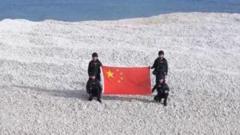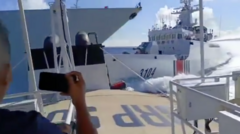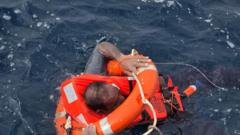In a contentious development, the Chinese coastguard has taken control of a small sandbank in the highly disputed South China Sea, escalating an ongoing territorial dispute with the Philippines. Reports from Chinese state media, including CCTV, revealed images of coastguard officers standing confidently on the contested Sandy Cay reef in the Spratly Islands, marking their intention to assert “sovereign jurisdiction” over the area.
Beijing's Latest Move: Tiny Sandbank Seized in South China Sea Dispute

Beijing's Latest Move: Tiny Sandbank Seized in South China Sea Dispute
China escalates territorial claims as tensions rise between Beijing and the Philippines over maritime rights.
This move prompted the Philippine government to underscore its own territorial claims, as Philippine officials recently landed on three sandbanks, showcasing their flag in a symbolic gesture reminiscent of China’s recent display. The National Task Force West Philippine Sea (NTF-WPS) reported sightings of a Chinese coastguard vessel and multiple militia boats in proximity to the sandbanks, raising alarms about China's increasing presence in the region.
The growing tensions have resulted in frequent maritime confrontations, with various incidents of vessel collisions and aggressive actions reported. Sandy Cay is strategically positioned near a Philippine military post on Thitu Island, which Manila utilizes to monitor Chinese activities in the nearby waters. While it appears that the Chinese coastguard has not established a permanent presence on the 200 sq meter sandbank, the White House expressed concerns over the potential impact of such actions on regional stability and adherence to international law.
These developments coincided with joint military exercises between the US and Philippine forces, known as Balikatan, aiming to enhance national defense capabilities amidst escalating threats. These annual drills, involving substantial military personnel and advanced offensive systems, are a clear signal of solidarity against external pressures, particularly from China.
The South China Sea continues to be a flashpoint for territorial disputes, with multiple nations asserting claims over various islands and maritime zones, particularly as China exercises expansive territorial ambitions, evidenced by its self-defined "nine-dash line." With history suggesting ongoing friction, analysts are closely monitoring these developments and calling for dialogue to resolve the intricate web of disputes in the region.
The growing tensions have resulted in frequent maritime confrontations, with various incidents of vessel collisions and aggressive actions reported. Sandy Cay is strategically positioned near a Philippine military post on Thitu Island, which Manila utilizes to monitor Chinese activities in the nearby waters. While it appears that the Chinese coastguard has not established a permanent presence on the 200 sq meter sandbank, the White House expressed concerns over the potential impact of such actions on regional stability and adherence to international law.
These developments coincided with joint military exercises between the US and Philippine forces, known as Balikatan, aiming to enhance national defense capabilities amidst escalating threats. These annual drills, involving substantial military personnel and advanced offensive systems, are a clear signal of solidarity against external pressures, particularly from China.
The South China Sea continues to be a flashpoint for territorial disputes, with multiple nations asserting claims over various islands and maritime zones, particularly as China exercises expansive territorial ambitions, evidenced by its self-defined "nine-dash line." With history suggesting ongoing friction, analysts are closely monitoring these developments and calling for dialogue to resolve the intricate web of disputes in the region.





















